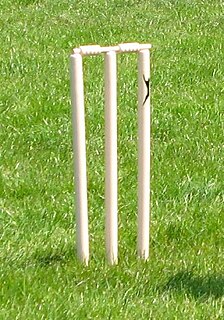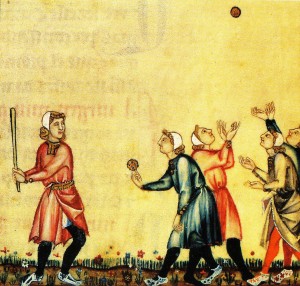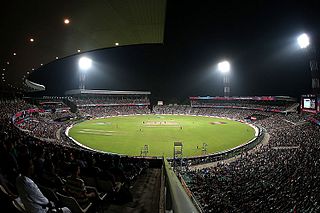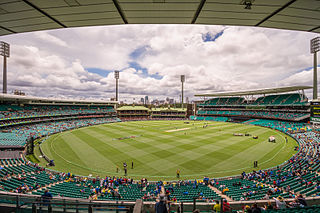
Bowling, in cricket, is the action of propelling the ball toward the wicket defended by a batsman. A player skilled at bowling is called a bowler; a bowler who is also a competent batter is known as an all-rounder. Bowling the ball is distinguished from throwing the ball by a strictly specified biomechanical definition, which restricts the angle of extension of the elbow. A single act of bowling the ball towards the batsman is called a ball or a delivery. Bowlers bowl deliveries in sets of six, called an over. Once a bowler has bowled an over, a teammate will bowl an over from the other end of the pitch. The Laws of Cricket govern how a ball must be bowled. If a ball is bowled illegally, an umpire will rule it a no-ball. If a ball is bowled too wide of the striker for the batsman to be able to play at it with a proper cricket shot, the bowler's end umpire will rule it a wide.

Fielding in the sport of cricket is the action of fielders in collecting the ball after it is struck by the striking batter, to limit the number of runs that the striker scores and/or to get a batter out by either catching a hit ball before it bounces, or by running either batter out before they can complete the run they are currently attempting. There are a number of recognised fielding positions, and they can be categorised into the offside and leg side of the field. Fielding also involves preventing the ball from going to or over the edge of the field.

Leg before wicket (lbw) is one of the ways in which a batsman can be dismissed in the sport of cricket. Following an appeal by the fielding side, the umpire may rule a batter out lbw if the ball would have struck the wicket but was instead intercepted by any part of the batter's body. The umpire's decision will depend on a number of criteria, including where the ball pitched, whether the ball hit in line with the wickets, the ball's expected future trajectory after hitting the batsman, and whether the batter was attempting to hit the ball.
The Laws of Cricket is a code which specifies the rules of the game of cricket worldwide. The earliest known code was drafted in 1744 and, since 1788, it has been owned and maintained by its custodian, the Marylebone Cricket Club (MCC) in London. There are currently 42 Laws which outline all aspects of how the game is to be played. MCC has re-coded the Laws six times, the seventh and latest code being released in October 2017. The 2nd edition of the 2017 Code came into force on 1 April 2019. The first six codes prior to 2017 were all subject to interim revisions and so exist in more than one version.
In the game of cricket, the cricket pitch consists of the central strip of the cricket field between the wickets. It is 22 yd (20.12 m) long and 10 ft (3.05 m) wide. The surface is flat and is normally covered with extremely short grass, but can be completely dry or dusty soil with barely any grass or, in some circumstances, made from an artificial material. Over the course of a cricket match, the pitch is not repaired or altered other than in special circumstances - meaning that it will change condition. Any grass on the pitch in the game's first over, for example, may have disappeared by the twentieth over due to wear.

In cricket, the term wicket has several meanings:

This is a general glossary of the terminology used in the sport of cricket. Where words in a sentence are also defined elsewhere in this article, they appear in italics. Certain aspects of cricket terminology are explained in more detail in cricket statistics and the naming of fielding positions is explained at fielding (cricket).

The leg side, or on side, is defined to be a particular half of the field used to play the sport of cricket. It is the side of the field that corresponds to the batsman's non-dominant hand, from their perspective.

In cricket, a wide is one of two things:

In cricket, batting is the act or skill of hitting the ball with a bat to score runs and prevent the loss of one's wicket. Any player who is currently batting is a batter,batsman or batswoman, regardless of whether batting is their particular area of expertise. Batting players have to adapt to various conditions when playing on different cricket pitches, especially in different countries - therefore, as well as having outstanding physical batting skills, top-level batters will have lightning reflexes, excellent decision-making and be good strategists.
Infield is a sports term whose definition depends on the sport in whose context it is used.
The outfield, in cricket and baseball, is the area of the field of play further from the batsman or batter than the infield. In association football (soccer), the outfield players are positioned outside the goal area.

A baseball field, also called a ball field or baseball diamond, is the field upon which the game of baseball is played. The term can also be used as a metonym for a baseball park. The term sandlot is also sometimes used, although this usually refers to less organized venues for activities like sandlot ball.

Cricket and baseball are the best-known members of a family of related bat-and-ball games. Both have fields that are 400 feet (120 m) or more in diameter between their furthest endpoints, offensive players who can hit a thrown/"bowled" ball out of the field and run between safe areas to score runs (points) at the risk of being gotten out, and have a major game format lasting about 3 hours.
Danish Longball is a bat-and-ball game founded by Graham Evans. It is popular in some British secondary schools, and is also played recreationally by scouts, the Air Training Corps, Wetheringsett Camp Suffolk and by the Royal Navy and Australian Navy. It is also a popular sport at U.S. summer camps.
In cricket, the batting order is the sequence in which batters play through their team's innings, there always being two batters taking part at any one time. All eleven players in a team are required to bat if the innings is completed.

The batter's eye or batter's eye screen is a solid-colored, usually dark area beyond the center field wall of a baseball stadium, that is the visual backdrop directly in the line of sight of a baseball batter, while facing the pitcher and awaiting a pitch. This dark surface allows the batter to see the pitched ball against a sharply contrasted and uncluttered background. Its purpose is the safety and hitting success of the batter. The use of a batter's background has been standard in baseball since at least the late 19th century. The batter's eye performs the same role at a baseball venue as the sight-screen does at a cricket venue, except that a cricket sight-screen is usually white in order to contrast with the dark red cricket ball. Alternatively a black screen is used to contrast the white Limited Overs cricket ball.

Bat-and-ball games are field games played by two opposing teams, in which the action starts when the defending team throws a ball at a dedicated player of the attacking team, who tries to hit it with a bat and run between various safe areas in the field to score runs (points), while the defending team can use the ball in various ways against the attacking team's players to force them off the field when they are not in safe zones, and thus prevent them from further scoring. The best known modern bat-and-ball games are cricket and baseball, with common roots in the 18th-century games played in England.

Cricket is a bat-and-ball game played between two teams of eleven players on a field at the centre of which is a 22-yard (20-metre) pitch with a wicket at each end, each comprising two bails balanced on three stumps. The game proceeds when a player on the fielding team, called the bowler, "bowls" (propels) the ball from one end of the pitch towards the wicket at the other end. The batting side's players score runs by striking the bowled ball with a bat and running between the wickets, while the bowling side tries to prevent this by keeping the ball within the field and getting it to either wicket, and dismiss each batter. Means of dismissal include being bowled, when the ball hits the stumps and dislodges the bails, and by the fielding side either catching a hit ball before it touches the ground, or hitting a wicket with the ball before a batter can cross the crease line in front of the wicket to complete a run. When ten batters have been dismissed, the innings ends and the teams swap roles. The game is adjudicated by two umpires, aided by a third umpire and match referee in international matches.

In cricket, a ground is a location where cricket matches are played, comprising a cricket field, cricket pavilion and any associated buildings and amenities.














